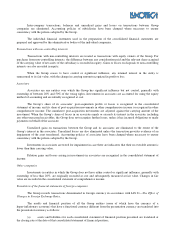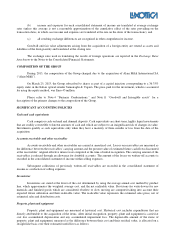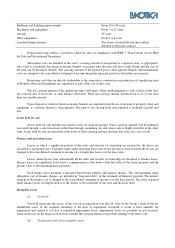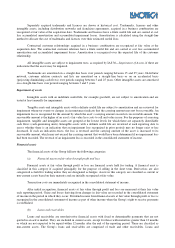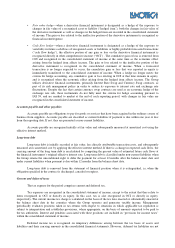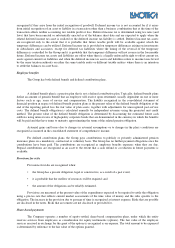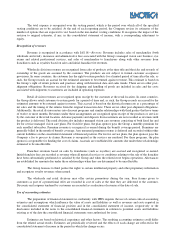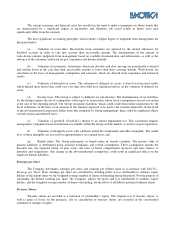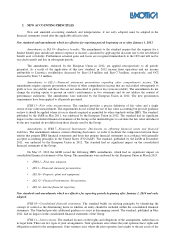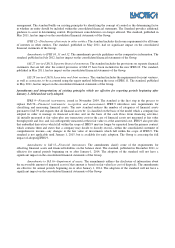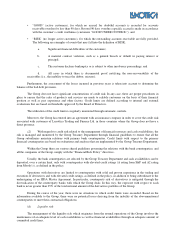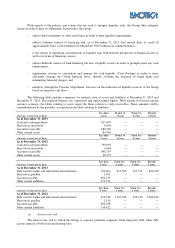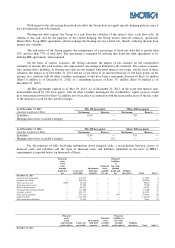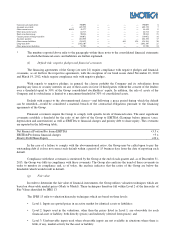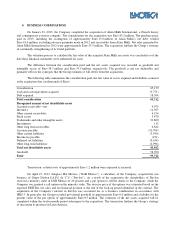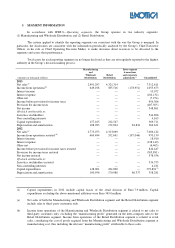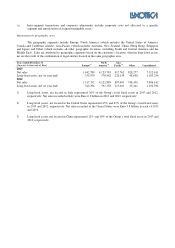LensCrafters 2013 Annual Report Download - page 110
Download and view the complete annual report
Please find page 110 of the 2013 LensCrafters annual report below. You can navigate through the pages in the report by either clicking on the pages listed below, or by using the keyword search tool below to find specific information within the annual report.
2. NEW ACCOUNTING PRINCIPLES
New and amended accounting standards and interpretations, if not early adopted, must be adopted in the
financial statements issued after the applicable effective date.
New standards and amendments which are effective for reporting periods beginning on or after January 1, 2013.
Amendments to IAS 19—Employee benefits. The amendments to the standard require that the expense for a
funded benefit plan include net interest expense or income, calculated by applying the discount rate to the net defined
benefit asset or liability. Furthermore actuarial gains and losses are recognized immediately in the OCI and will not be
recycled to profit and loss in subsequent periods.
The amendments, endorsed by the European Union in 2012, are applied retrospectively to all periods
presented. As a result of the application of this new standard, in 2012 income from operations and net income
attributable to Luxottica stockholders decreased by Euro 11.9 million and Euro 7.3 million, respectively, and OCI
increased by Euro 7.3 million.
Amendments to IAS 1—Financial statements presentation regarding other comprehensive income. The
amendments require separate presentation of items of other comprehensive income that are reclassified subsequently to
profit or loss (recyclable) and those that are not reclassified to profit or loss (non-recyclable). The amendments do not
change the existing option to present an entity’s performance in two statements and do not address the content of
performance statements. The amendments were endorsed by the European Union in 2012. The new presentation
requirements have been applied to all periods presented.
IFRS 13—Fair value measurements. The standard provides a precise definition of fair value and a single
source of fair value measurement. The requirements do not extend the use of fair value accounting but provide guidance
on how it should be applied where its use is already required or permitted by other standards within IFRS. The standard,
published by the IASB in May 2011, was endorsed by the European Union in 2012. The standard had no significant
impact on the consolidated financial statements of the Group as the methodologies to calculate the fair value introduced
by the new standard do not differ from those already used by the Group.
Amendments to IFRS 7—Financial Instruments: Disclosures on offsetting financial assets and financial
liabilities. The amendments enhance current offsetting disclosures in order to facilitate the comparison between those
entities that prepare IFRS financial statements and those that prepare financial statements in accordance with generally
accepted accounting principles in the United States (US GAAP). The standard, published by the IASB in December
2011, was endorsed by the European Union in 2012. The standard had no significant impact on the consolidated
financial statements of the Group.
On May 17, 2012 the IASB issued the following IFRS amendments, which had no significant impact on
consolidated financial statements of the Group. The amendments were endorsed by the European Union in March 2013.
• IFRS 1—First time adoption.
• IAS 1—Financial statement presentation.
• IAS 16—Property, plant and equipment.
• IAS 32—Financial instruments: Presentation.
• IAS 34—Interim financial reporting.
New standards and amendments which are effective for reporting periods beginning after January 1, 2014 and early
adopted.
IFRS 10—Consolidated financial statements. The standard builds on existing principles by identifying the
concept of control as the determining factor in whether an entity should be included within the consolidated financial
statements. The Standard provides additional guidance to assist in determining control. The standard, published in May
2011, had no impact on the consolidated financial statements of the Group.
IFRS 11—Joint ventures. The standard focuses on the rights and obligations of the arrangement, rather than on
its legal form. There are two types of joint arrangements. Joint operations arise where the joint operators have rights and
obligations related to the arrangements. Joint ventures arise where the joint operators have rights to the net assets of the



